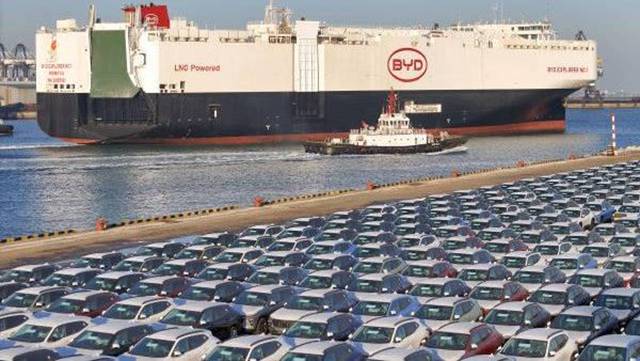BMW and Bentley owners got into a fight, but BYD made a fortune.
A few days ago, a video clip titled “Hangzhou Bentley Driver Assaults and Injures Someone” went viral. In the video, the owner of a Bentley is seen wielding a sharp knife, repeatedly stabbing the owner of a BMW and knocking him down.
Meanwhile, during the incident, a passing BYD owner (a professional lawyer) stopped his car to intervene, shielding the injured person with half of his body to prevent further violence. He calmly smoked a cigarette during the process, earning praise from netizens.
The brave individual in question is Mr. Sun, a lawyer from Hangzhou, who rightfully deserves the spotlight.
However, BYD also seized the opportunity, promptly announcing lifetime free maintenance for the lawyer’s vehicle and awarding him 200,000 yuan, successfully gaining more supporters.
Furthermore, BYD publicly declared:
The company is considering establishing the “BYD Positive Energy and Good Samaritan Award” to reward owners who exhibit positive energy and acts of bravery with amounts ranging from 50,000 to 200,000 yuan.
From a marketing perspective, this is an excellent strategy.
Bentley, BMW, and BYD all start with the letter “B.”
In terms of market positioning, Bentley naturally stands at the top, while BYD follows a more “mass-oriented” approach.
However, this incident fully demonstrates that BYD owners are in no way inferior to Bentley owners in terms of character and demeanor.
Being a lawyer adds to Mr. Sun’s commendable traits, representing intellectual elites.
On the other hand, the BMW and Bentley owners involved in the incident are merely cousins embroiled in a dispute over interests, resorting to physical violence.
Such a contrast immediately elevates the image of BYD owners.
In fact, on the other side of town, a Tesla owner also participated in aiding and reporting to the authorities. However, due to Tesla’s lack of effective publicity, the opportunity fell into BYD’s lap.
Consumer social recognition is akin to Maslow’s hierarchy of needs theory, where consumers seek social acceptance through the brands they consume.
With this incident, many BYD owners naturally feel a sense of pride.
Looking forward to the upcoming launch of the U9, priced at 1.68 million yuan.
Moreover, this is a positive event that serves as a model for guiding society towards positivity.
“A good reputation, once broken, may possibly be repaired, but the world will always keep their eyes on the spot where the crack was.”
BYD’s timely actions, with a cost of 200,000 yuan, have garnered far more positive effects than advertising worth millions, significantly enhancing the company’s image and brand value.
Utilizing resources effectively is indeed a hallmark of good management, and BYD’s marketing strategy exemplifies this.
This also aligns well with BYD’s promotional needs, as the company initially started with low-end vehicles, even being dubbed as the “best imitator of Toyota.”
However, with BYD’s continuous improvement in vehicle quality, increased sales, the launch of high-end brands like “Yanwang,” and the success of its new energy strategy, its product quality, innovation, and brand image have undergone significant transformations.
At this juncture, BYD must undoubtedly engage in a series of promotions to establish its brand among the ranks of luxury car manufacturers.
This incident provides a perfect opportunity for that.
BYD’s marketing campaign has also provided numerous new consumer brands with new perspectives.
Choosing brand ambassadors doesn’t necessarily have to mean selecting celebrities; ordinary people with positive stories from popular news might be more effective.
In reality, the return on investment for inviting entertainment celebrities as brand ambassadors has been diminishing.
Not only do they demand exorbitant fees, but they also carry the risk of tarnishing the brand’s image due to personal scandals.
Celebrities like Kris Wu and Li Yifeng have caused losses to the brands they endorsed.
Hence, in recent years, there has been a growing trend of sports stars being used for brand promotion.
Mainly focusing on positive images, and with relatively lower risks of negative publicity.
However, the costs of packaging endorsements remain high. For instance, Gu Ailing’s endorsement fees are around 20 million RMB.
Brands she has endorsed include Quark, Kohler, Genki Forest, Midea, Luckin Coffee, Tong Ren Tang, and many more.
How effective are these endorsements?
It’s hard to say, but compared to the effect of BYD’s 200,000 yuan investment resulting in days of trending on social media, it certainly lacks cost-effectiveness.
Therefore, BYD has provided a new way of thinking:
Identify the brands used by individuals involved in positive events and empower those associations to strengthen brand promotion.
With a 200,000 yuan marketing campaign, achieve the effect of 20 million yuan.
Of course, this isn’t a novel idea by BYD.
Many brands in Europe and America have employed similar strategies.
Before BYD, Chery once rode on the popularity of “internet-famous grandma driving” to trend multiple times.
Small investments, big impacts, a strategy worth emulating.
However, BYD’s marketing campaign still has its flaws, primarily being criticized for “riding on the wave.”
Corporate management and brand image are short-term powers.
However, societal image represents the longest-lasting power.
Unlike brand image, societal image focuses on long-termism, requiring stable and continuous output to the public.
Great and long-lasting brands often prioritize long-termism, possessing firm and clear values rather than focusing solely on short-term gains.
For BYD to truly become a respected company in China and worldwide, there are more important tasks at hand.
Namely: how to make the company itself a benchmark of social values.
Starting from imitating the Santana, Chinese automobile brands have now built complete automobile production chains and even overtaken the leading powers in Germany, Japan, and the United States in the field of new energy vehicles.
Such progress is indeed something to be proud of.
Looking at it from a global perspective, few countries have achieved such significant progress within 30 years.
However, on the other hand, this market success hasn’t brought much happiness to individuals or consumers.
China’s service industry accounts for only 26% of consumption, whereas it’s 55% in the United States and approximately 40% in the European Union and Japan.
This indicates that Chinese people lack both money and time for consumption.
The development of the service industry also relies on the improvement of market rules and the protection of labor rights.
There’s a need to reduce the intensity of work and provide higher wages to grassroots employees.
In this regard, German automakers have done a good job; an ordinary auto worker can lead a decent life in society.
This requires the high premium of the high-tech industry to diffuse through different industrial chains, allowing people from all walks of life to share the benefits of industrial growth.
For BYD, establishing a longer-term social image should involve setting an example by improving workers’ compensation and rest time within the company.
Efforts should be made in areas such as battery recycling, community activities, and environmental conservation.
It’s well-known that the investment community now pays special attention to a company’s ESG (Environmental, Social, and Governance) score.
This system evaluates companies based on three dimensions: Environment, Social, and Governance.
The U.S. SEC (Securities
and Exchange Commission) mandates that listed companies disclose their ESG information.
In the future, Chinese companies’ success in overseas markets will largely depend on the improvement of their ESG systems to establish themselves abroad.
This is an area where companies like BYD need to persistently strive for improvement.
BYD’s marketing campaign has certainly opened up a new way of thinking:
By tapping into the daily consumer habits of those involved in positive events, empowering those associations, and strengthening brand promotion.
With a 200,000 yuan investment, achieving the effect of 20 million yuan.
Of course, BYD isn’t the first to do this.
Many brands in Europe and America have adopted similar strategies.
Before BYD, Chery once capitalized on the popularity of “internet-famous grandma driving” to trend multiple times.
Small investments, big impacts, a strategy worth emulating.
However, BYD’s marketing campaign still has its flaws, primarily being criticized for “riding on the wave.”
Corporate management and brand image are short-term powers.
However, societal image represents the longest-lasting power.
Unlike brand image, societal image focuses on long-termism, requiring stable and continuous output to the public.
Great and long-lasting brands often prioritize long-termism, possessing firm and clear values rather than focusing solely on short-term gains.
For BYD to truly become a respected company in China and worldwide, there are more important tasks at hand.
Namely: how to make the company itself a benchmark of social values.
Starting from imitating the Santana, Chinese automobile brands have now built complete automobile production chains and even overtaken the leading powers in Germany, Japan, and the United States in the field of new energy vehicles.
Such progress is indeed something to be proud of.
Looking at it from a global perspective, few countries have achieved such significant progress within 30 years.
However, on the other hand, this market success hasn’t brought much happiness to individuals or consumers.
China’s service industry accounts for only 26% of consumption, whereas it’s 55% in the United States and approximately 40% in the European Union and Japan.
This indicates that Chinese people lack both money and time for consumption.
The development of the service industry also relies on the improvement of market rules and the protection of labor rights.
There’s a need to reduce the intensity of work and provide higher wages to grassroots employees.
In this regard, German automakers have done a good job; an ordinary auto worker can lead a decent life in society.
This requires the high premium of the high-tech industry to diffuse through different industrial chains, allowing people from all walks of life to share the benefits of industrial growth.
For BYD, establishing a longer-term social image should involve setting an example by improving workers’ compensation and rest time within the company.
Efforts should be made in areas such as battery recycling, community activities, and environmental conservation.
It’s well-known that the investment community now pays special attention to a company’s ESG (Environmental, Social, and Governance) score.
This system evaluates companies based on three dimensions: Environment, Social, and Governance.
The U.S. SEC (Securities and Exchange Commission) mandates that listed companies disclose their ESG information.
In the future, Chinese companies’ success in overseas markets will largely depend on the improvement of their ESG systems to establish themselves abroad.
This is an area where companies like BYD need to persistently strive for improvement.

